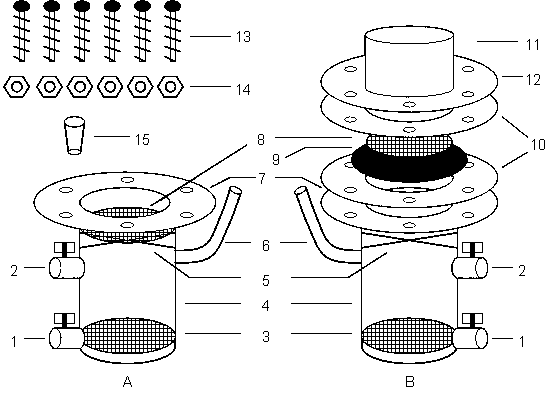Structure-variable soil microbial fuel cell
A technology of soil microorganisms and fuel cells, applied in biochemical fuel cells, climate sustainability, sustainable manufacturing/processing, etc., can solve problems such as limitations, increase battery internal resistance, anaerobic conditions are not as good as double-chamber structures, etc., and achieve acquisition Convenience, Enhanced Durability, Ease of Soil Access
- Summary
- Abstract
- Description
- Claims
- Application Information
AI Technical Summary
Problems solved by technology
Method used
Image
Examples
Embodiment Construction
[0017] The present invention provides a soil microbial fuel cell with a variable configuration, and the specific implementation will be described below with reference to the accompanying drawings.
[0018] Example 1: In a single-chamber configuration (A), the reactor has a height of 30 cm, an external diameter of 15 cm, and a wall thickness of 0.4 cm. The anode (3) is made of 20 cm×20 cm carbon cloth, and the cathode (5) is made of carbon cloth with a diameter of 15 cm. Lead one end of the anode wire out from the anode wire tube (6) and pass through the rubber plug (15), then plug the anode wire tube tightly with the rubber plug; the other end of the wire is connected to the carbon cloth of the anode (3). Arrange the carbon in the anode chamber (4), pour 1000 g of fresh soil mixed with 6% glucose into the anode chamber, add distilled water until the cross support (5) is covered; spread the carbon cloth of the cathode (8) on the cross support Make sure that the water surface i...
PUM
 Login to View More
Login to View More Abstract
Description
Claims
Application Information
 Login to View More
Login to View More - R&D
- Intellectual Property
- Life Sciences
- Materials
- Tech Scout
- Unparalleled Data Quality
- Higher Quality Content
- 60% Fewer Hallucinations
Browse by: Latest US Patents, China's latest patents, Technical Efficacy Thesaurus, Application Domain, Technology Topic, Popular Technical Reports.
© 2025 PatSnap. All rights reserved.Legal|Privacy policy|Modern Slavery Act Transparency Statement|Sitemap|About US| Contact US: help@patsnap.com

